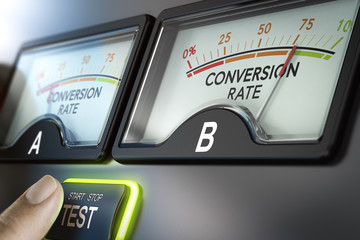We’ll increase conversions by
20-100+%
on your website.
Get a FREE Audit today
See how we can help your business increase conversion rates
Conversion Testing Information
Introduction
Are you tired of making changes to your website without knowing if they’re actually making a difference? That’s where the great thing about conversion testing comes in. Conversion testing is the process of measuring the impact of change on website conversions, and it can help you determine if a change is statistically significant or just happenstance.
Data plays an important role in this process, as do simplicity and choosing the right tools. By optimizing different content on your website for conversions, you can increase revenue while minimizing costs. So let’s dive into the world of conversion testing and learn how to improve user experience and persuade visitors to take desired actions on your website!
Understanding Conversion Testing
Conversion testing is the process of evaluating the impact of changes made on a website to determine if they have a statistically significant effect on conversions and can ultimately increase revenue.
Definition And Purpose
Conversion testing is a powerful technique used to measure the effects of changes made to a website or app. It involves comparing two versions of a webpage, each with different elements, in order to determine which version performs better in terms of conversions. The purpose of conversion testing is to make data-driven decisions about which design elements on a website or app will lead to improved user engagement and more sales.
By analyzing the results obtained from conversion testing, businesses can gain valuable insights into what works best for their target audience. This information can then be used to optimize their web-based application pages and increase revenue per visitor. Conversion testing also allows teams working on web-based applications to verify that data is being correctly converted from one data format to another, ensuring that the web-based application functions as expected when live.
Importance And Benefits
Conversion testing is important because it helps businesses make data-driven decisions. By testing different variations of a website or landing page, companies can determine which elements are most effective in driving conversions and increasing revenue. This process can also identify areas for improvement and optimization.
The benefits of conversion testing include improved user experience, increased engagement, higher conversion rates, and ultimately higher profits. By optimizing web pages to appeal to users’ needs and preferences, companies can increase the likelihood that visitors will make a purchase or take some other desired action on their site. Additionally, by identifying the most successful variables through testing techniques like A/B testing or regression testing, businesses can allocate resources more effectively towards strategies that yield the greatest returns on investment.
Types Of Conversion Testing
There are different types of conversion testing that businesses can use to improve their online presence and boost conversions. One type is the data format conversion testing, which involves verifying the successful conversion rate of one data format to another in software testing. Another type is A/B testing, where two versions of a web page or app are compared to see which has a higher conversion rate.
Another common types form of test technique is interface testing, which ensures that all components of an application work together seamlessly through rigorous tests. Decision Testing takes into account the technical and business requirements web based application while creating test cases to provide maximum coverage for critical actions on web pages or applications.
Factors To Consider Before Conducting A Conversion Test
Before conducting a conversion test, it is important to consider factors such as measuring conversions such as secondary objectives straight conversion amount, identifying conversion goals and secondary objectives, determining testing traffic volume, ensuring statistical significance, and effective data analysis.
Identifying Conversion Goals
Identifying conversion goals is a crucial step in planning a successful conversion test. Simply put, the goal of CRO is to increase conversions and improve website performance. This means that you need to identify what constitutes as a “conversion” for your particular website or business. For example, if you are selling products online, your conversion goal may be getting customers to complete the checkout process.
Once you have defined your conversion goal, it’s important to measure its effectiveness by tracking key metrics such as conversion rates and revenue per visitor. By monitoring these metrics, you can identify areas where improvements can be made straight your conversion rate, and develop strategies for micro conversion and optimizing overall website performance.
Remember that identifying an effective conversion goal requires considering different factors such as audience demographics, website performance metrics and potential impact on other marketing campaigns. To make sure that your testing efforts are aimed at achieving specific goals, it’s important to continually assess metrics throughout the optimization process. So keep track of all this data while conducting tests so that you can properly analyze results later on!
Determining Testing Traffic Volume
Determining testing traffic volume is crucial before conducting a conversion test. This helps to ensure the reliability and accuracy of the results obtained from split testing. It’s important to allocate traffic equally between variants in A/B tests, although this may not always be feasible due to cost and benefit considerations for the duration of the test.
Unequal distribution can lead to skewed results, causing inaccurate conclusions about which variant performs better than others. By determining adequate traffic volumes upfront, it becomes clear whether you are likely to reach statistical significance or need to alter your testing strategy. Take into account factors like website visitors, mobile users versus desktop users, and high-value page interactions when deciding on how much traffic is needed for accurate results.
Ensuring Statistical Significance
Ensuring statistical significance is crucial for achieving accurate and reliable results in conversion testing. Statistical significance means that the observed differences between test variations are not just due to chance, but are actually a result of the changes made in the test. Before conducting a conversion test, it is important to determine the appropriate sample size and traffic volume needed to reach statistical significance.
Testing pages with high traffic or high conversion rates can help reach statistical significance more quickly than low-traffic pages. However, it’s important to remember that statistical significance alone does not guarantee success – other factors like user experience and content also play a role in driving conversions. A strong understanding of A/B testing statistics is crucial for achieving real lift in conversion rates and ensuring that tests are designed correctly to produce accurate results.
Effective Data Format or Analysis
In conversion testing, data analysis is a critical step in determining which version of a webpage better drives conversions. It involves collecting and interpreting data from the test variations to identify patterns and insights for improvement.
To ensure effective data analysis, it’s crucial to define specific metrics that align with business objectives and check for statistical significance.
Once the data micro conversion, is collected, analyzing it requires making sense of complex datasets through visualization tools and data format such as tables or graphs. This helps to clearly identify objects, display trends over time and highlight any outliers or anomalies within the results. With these insights, CRO teams can make informed decisions on how best to optimize pages to improve conversion rates for their website visitors.
Steps To Conducting A Successful Conversion Test
To conduct a successful conversion test selling online only, it’s important to set clear goals and objectives, choose the right testing tool, develop testable hypotheses, identify common test examples objects create test variations, run the test and collect data, and analyze results – read on to learn more about each step!
Setting Clear Goals And Objectives
When it comes to conversion testing, setting clear goals and objectives is absolutely essential for success. A goal represents a specific action completed by the user, such as making a purchase or filling out a form. To choose the right metrics for A/B testing, it’s important to select goals that make sense given the nature of your website or business.
Objectives are also critical in conversion testing. These are specific steps that lead to the successful completion of a project like improving conversion rates. By breaking down larger goals into smaller objectives, you can create achievable benchmarks that guide your progress along the way. With careful planning and attention to detail, you can achieve impressive results through content enhancements, split-testing, and workflow improvements – all supported by clearly defined objectives aimed at maximizing your conversions according to [IMPORTANT FACTS].
Choosing The Right Testing Tool
When it comes to conducting successful conversion tests, choosing the right testing tool is essential. With multiple A/B testing tools available in the market, selecting the most suitable one can be overwhelming. The ideal A/B testing tool should have features such as advanced targeting options, an easy set-up process, and robust reporting capabilities.
One of the most popular A/B testing tools used by businesses is Google Optimize. With its user-friendly interface and integration with Google Analytics, this tool provides a comprehensive solution for analyzing website performance and making data-driven decisions.
Multivariate testing, on the other hand, allows businesses to test multiple variations of site elements simultaneously to determine which combination works best for improving conversion rates. By selecting the right testing tool for their needs, businesses can effectively evaluate different versions of different content on their web pages to identify what works best for their target audience.
Developing Testable Hypotheses
Developing testable hypotheses is a crucial step in conducting a successful conversion test in CRO marketing and something our conversion optimisation consultants at Convertica always include in our testing process. It involves identifying potential obstacles on the original page that can decrease conversions and generating hypotheses aimed at improving the conversion rate. By developing well-crafted, data-backed, and relevant hypotheses, marketers can make better decisions and optimize their websites to deliver an improved user experience.
A solid hypothesis is necessary for every marketing experimentation process, as it helps to establish clear goals and objectives. Hypotheses should be sorted by relevance for innovation, such as product or service-related problems that users face when navigating your site.
By narrowing down the list of possible issues in this way, you can develop more focused experiments that are meaningful to your business’s bottom line.
In conclusion, hypothesis-driven development involves pairing a statement that asserts or predicts value with a testable condition that can be measured.
Therefore spending time on formulating business testing a strong hypothesis will help you identify UX or conversion-related problems effectively while optimizing your website pages efficiently.
Creating Test Variations
Creating test variations is a critical part of conversion testing. When creating variations, it’s important to have clear goals and objectives in mind for comparison. Factors like button placement or text can impact the overall success of a web page, so small changes can make a big difference.
Choosing the right testing tool to create accurate variations is also crucial. Popular tools like Google Optimize or VWO offer A/B testing options that are easy to use and implement. Developing testable hypotheses allows you to better understand what elements on your web page may be impacting conversions and determine which areas need improvement.
By selecting the proper tool, developing hypotheses effectively, and creating suitable test variations, companies can observe true results and improve their website’s performance over time with successful conversion testing techniques.
Running The Test And Collecting Data
Running a conversion test is where the magic happens! This step involves running the variations created and collecting data on how visitors interact with them.
It’s important to ensure that both versions are live simultaneously so that you can measure their performance side-by-side. Depending on your testing tool, you will be able to track various metrics such as click-through rates, bounce rates, revenue per visitor, and other relevant KPIs.
Once enough data from b test has been collected (generally no less than two weeks), statistical analysis can be performed to determine which version statistically outperformed the other. It’s important to note that achieving statistical significance is key in determining the true results of an A/B test. If not achieved, it’s likely due to lack of volume enough data or time spent running the test – meaning b test results may not be accurate or trustworthy.
Analyzing Results And Drawing Conclusions
In conclusion, conversion testing is an essential process for any website looking to optimize user experience and increase revenue. By analyzing results and drawing conclusions, businesses can make data-driven decisions that can have a positive effect on their bottom line.
Simple and cost-effective, conversion testing helps to determine the effectiveness of changes made to a website while ensuring statistical significance. With several techniques available, even low-traffic websites can benefit from implementing conversion testing.
So why wait? Start measuring conversions today and make informed decisions that will lead to a better user experience for your website visitors!
Key Metrics To Measure In Conversion Testing
Measuring conversion rates, click-through rates, bounce rates and revenue per visitor are some of the key metrics to consider in conversion testing.
Conversion Rates
Conversion rates are a crucial metric to consider in conversion testing. It refers to the percentage of website or mobile visitors, who take an action that achieves the company’s acquisition goals out of total interactions or traffic. Measuring conversion rates is essential for businesses, as it allows them to determine their profitability and forecast future success.
One important aspect of measuring conversions from mobile visitors is tracking click-through rate (CTR). CTR measures the number of clicks on a specific page or link compared to its impressions or how often it appears online. By analyzing CTR data, businesses can identify which web elements are performing well and optimize their design accordingly.
In conclusion, understanding and optimizing conversion rates is critical for ensuring business success. By tracking metrics like CTR, companies can make informed decisions about website design and marketing strategies that drive high-value interaction with users.
Click-Through Rates
Click-through rate (CTR) is a crucial metric that measures how many people clicked on an ad or link to visit a website or landing page. It is calculated by dividing the number of clicks by the number of impressions and shown as a percentage.
While CTR is important for measuring engagement, it should not be confused with conversion rate which measures the number of visitors who complete a desired action.
In conversion testing, CTR can be used as an essential secondary metric alongside the primary conversion goal to gain valuable insights into user behavior and engagement levels. For example, if two versions of a web page are being tested to determine which version leads to more conversions, tracking CTR for both web pages together can help identify which version generates higher traffic and interest from users.
Overall, understanding CTR’s importance in measuring performance is crucial when conducting conversion testing. It helps provide additional data points beyond just conversion rates and allows businesses to optimize their websites and marketing strategies further effectively.
Bounce Rates
Bounce rate is a critical metric in measuring user engagement and the effectiveness of your website. It’s calculated by dividing single-page sessions with all sessions and can indicate how well your site’s entrance pages are performing. An average bounce rate falls between 41-51%, but if it goes above this range, you may need to re-evaluate the relevance of your site’s content to visitors.
A high bounce rate means that many people are leaving your website as soon as they enter, indicating a lack of interest or value in your content. This could negatively impact visit quality and conversion rates.
When looking at bounce rates, it’s most important things you to keep them in context with other metrics such as exit rates and user engagement metrics for an accurate evaluation of your site’s performance.
By understanding and optimizing bounce rates, you can improve the overall experience for users visiting your website.
Revenue Per Visitor
Revenue per visitor (RPV) is a crucial metric used by e-commerce businesses to measure the success of their website. It refers to the amount of money generated each time a customer visits a site, and it’s calculated by dividing total revenue by the number of unique visitors. RPV comprises two main metrics: conversion rate (CR) and average order value (AOV), both critical factors in driving revenue growth.
Measuring RPV helps businesses determine the impact of experimentation on their website, which is key in determining testing program success rates. To calculate RPV, you simply multiply CR by AOV for each experiment goal set.
Increasing your RPV requires working on improving either or both CR and AOV through various elements such as landing page optimization or marketing promotions that drive higher engagement with customers, ultimately leading to more conversions and increased revenue per visit.
Conversion Testing Techniques
There are various techniques for conversion testing, including regression testing, interface testing and decision testing. Read on to discover which technique is best suited to your website’s needs and how it can help boost conversions.
Regression Testing Technique
Regression testing is a crucial aspect of software development that ensures new changes or modifications don’t impact the existing functionality. It’s a type of black box testing technique used to verify if software behaves as expected after updates have been made. By conducting regression testing, developers can identify and fix any bugs or errors before they are released to users.
Functional regression testing is another kind of regressive test done on an app after adding new features or modifying existing ones. The aim is to ensure that the latest version meets all functional requirements while not affecting other areas of the application.
Selective regression test techniques offer additional benefits as they help in selecting only necessary tests cases which minimize the workload associated with complete regressions without compromising quality assurance efforts; hence it reduces cost and saves time by picking out essential test cases for retesting in subsequent releases.
Interface Testing
Interface testing is a crucial aspect of software testing that ensures the smooth interaction between different components and applications. This type of testing determines whether all aspects of an interface are functioning correctly, including input, output, and error handling.
Interface testing requires a comprehensive strategy that involves identifying the critical interactions between interfaces, creating test scenarios based on these interactions, and validating the results against expected behavior.
One significant advantage of interface testing is its ability to catch issues early in the development process. This allows developers to fix any problems before they become more complex and difficult to resolve. Interface failures can have far-reaching consequences on system performance, so it’s essential to take this type of testing seriously.
In practice, there are two primary forms of interface testing: API Testing (also known as Web Services Testing) and User Interface Testing. API Testing validates how APIs interact with other hardware or software components while User Interface Testing looks at how application users engage with various features displayed on screen.
Both methods require robust test cases that target every functionality within an application UI or service architecture. Furthermore, automation tools like Selenium WebDriver or SoapUI could be used to help speed up tests without compromising their accuracy level.
Decision Testing
Decision testing is a valuable conversion testing technique often used to test different input combinations. By creating a decision table, one can identify all possible inputs and their corresponding child objects or outputs. This helps in determining the best combination of inputs for optimal performance.
One of the most common examples of decision testing is button placement on a web page. Testing two versions with very different content and button placements can help determine which version leads to higher conversions. The results obtained from this type of testing can be used to make informed decisions about which version should be implemented on the website.
Overall, decision testing is an effective way to ensure that high value interactions on websites for mobile visitors are optimized and lead to maximum conversions.
It’s important for businesses to incorporate decision testing into their overall conversion optimization strategy, as it plays a critical role in improving website functionality and increasing revenue per visitor.
Job Stream Testing
Job Stream Testing is not commonly associated with Conversion Testing, but it can be useful in identifying critical actions that may impact conversion rates. This testing technique involves testing the flow of job streams or automated processes to ensure they are functioning correctly and efficiently. By identifying any errors or issues early on, businesses can prevent potential disruptions or downtime and improve website performance.
One of the key benefits of Job Steam Testing is its ability to identify missing data and ensure test traceability. It enables businesses to verify that a particular process has generated output data that corresponds with the expected input data. This type test traceability part of testing is especially important for websites selling online because it ensures high-value interactions like form submissions and transactions are handled reliably and accurately.
Conversion Testing Best Practices
Conversion testing best practices include creating a clear testing plan, using realistic data, testing both input and output data, automating testing where possible, and continuously monitoring and improving tests.
Creating A Clear Testing Plan
Creating a clear testing plan is crucial to the success of any conversion testing. With a clearly defined plan, you can identify objectives and ensure that all parties involved in the testing process are on the same page.
The first step in creating a clear testing plan is to establish what your goals are for your conversion test. This will help set expectations for everyone involved and define what metrics you will be measuring.
Once you have established your goals, it’s important to determine which technique you will use to test appropriately. Whether it’s A/B testing or data migration testing, choosing the right tool is essential for getting accurate results. As part of your plan, consider using automated tools like Google Optimize or SQL queries to collect data efficiently and accurately across multiple tests simultaneously.
By establishing test traceability with specific details on who tested what and when, processes can be monitored more effectively over time with less emphasis being placed on specific individuals b for test traceability for them.-
Testing Both Input And Output Data
When it comes to conversion testing, one of the best practices is to test both input and output data. This means that you should not only evaluate what users are entering into your website or application but also focus on what they’re getting out of it. By doing so, you can identify potential issues in the conversion funnel and address them accordingly.
Testing both input and output data is critical for ensuring accurate results when analyzing conversions. If there’s something wrong with either side of the equation, it could lead to skewed metrics or false positives/negatives.
For example, if a form isn’t coded correctly and doesn’t properly register user submissions (input), then any analysis of that form’s conversion rate (output) would be inaccurate. The same goes for any other high value interaction points on your website or application – like clicking a specific button – where testing both input and output data can help reveal insights about how users are interacting with them.
Using Realistic Data
Using realistic data is critical for accurate conversion testing. When running a test, it’s most important things is to use one data format that accurately represents the behavior of actual users. This means using real user data and not just theoretical or simulated scenarios.
One common mistake is using perfect or idealized versions of data, which can lead to inaccurate results once implemented in real-world scenarios. Instead, use representative samples of data from actual customers to ensure test validity.
Realistic data also helps identify potential issues before they become problems with live production systems. By understanding how users interact with the system through the use of realistic data, it becomes easier to anticipate issues and implement preventative measures during testing rather than after deployment.
Automating Testing Where Possible
Automating of business testing where possible is one of the best practices in conversion business testing.
Test automation increases effectiveness, test coverage, and execution speed while also reducing errors due to human intervention. By automating repetitive tasks, businesses can save time and money.
The importance of an effective test plan for data migration testing cannot be overemphasized. Testing the production run and using automated testing tools to test 100% of migrated data is highly recommended. Automated testing ensures that all migrated data meets quality assurance standards before it goes into production and minimizes downtime caused by incorrect or missing data.
In summary, automating testing where possible is vital in software development as it saves time, reduces costs, eliminates errors significantly and ensures that applications meet set requirements.
In addition to being a best practice in conversion testing, automated testing improves overall software quality by making sure that critical functionalities perform optimally under any condition throughout the software’s lifecycle.
Continuously Monitoring And Improving Tests
Continuous monitoring and improvement of tests is a critical aspect of conversion testing. It allows for ongoing refinement and enhancement of the testing process, leading to more accurate results and higher conversions over time.
This involves regularly analyzing data from tests, identifying areas where improvements can be made, and implementing changes to improve test performance.
One way to continuously monitor tests is through the use of A/B testing tools or website heat map + session recording tools. These allow you to track user behavior on your site, measure engagement with different elements such as buttons or forms, and identify areas that need optimization. Additionally, conversion-tracking analytics can provide valuable insights into which pages are driving conversions and which ones may need improvement.
In conclusion, continuous monitoring and improvement of tests are key to optimizing conversions over time. By regularly analyzing data from testing tools and making adjustments based on findings, businesses can improve their overall performance while enhancing the customer experience.
Common Conversion Testing Mistakes To Avoid
Some of most common types of conversion testing mistakes to avoid include testing too many elements at once, ignoring statistical significance, missing data, not analyzing data effectively, and failing to re-test and monitor results.
Testing Too Many Elements At Once
Testing too many variants or elements at once is a common mistake to avoid in conversion testing. When you test everything at once, it becomes difficult to determine what has made a difference and learn from it. Keeping the test to just one element change can help identify which factor caused an improvement or decline in your conversion rate.
Trying different time delays simultaneously during A/B testing is also a mistake to avoid. Focus on changing only one variable at a time when doing your A/B testing as comparing two versions of something allows you to figure out which performs better usually associated with website testing.
This process helps generate true results that will measure conversions for both macro conversions and micro to macro conversions, providing valid insights into customer behavior and preferences while helping optimize pages so they function more effectively for users, leaving business representatives satisfied with the positive effect of their efforts in the old system or new systems.
Ignoring Statistical Significance
Ignoring statistical significance in conversion testing can lead to inaccurate conclusions and false positives. It is essential to analyze the data with a critical eye, taking into account sample size, p-values, confidence intervals, and other relevant metrics before making any decisions about technical testing.
For instance, rushing to implement changes after seeing improvements in one test variation without considering statistical significance may negatively impact overall conversion rates.
A most common type of mistake among researchers is measuring only conversion rate and overlooking other crucial metrics like average order value or revenue per visitor. Conversion testing should encompass various performance indicators to paint an accurate picture of the user experience.
Suppose you focus solely on improving the conversion rate for a page during A/B testing but ignore bounce rates and retention time. In that case, it may result in short-term gains but could hurt overall engagement levels with your product.
In conclusion, ignoring statistical significance when conducting A/B tests can be detrimental to your business’s performance as incorrect assumptions can cause long-lasting negative effects on conversions. Robust data analysis methods like identifying and measuring statistically significant and performance indicators are integral for running successful tests that produce sustainable results over time.
Not Analyzing Converted Data Format Effectively
One of the most common mistakes made in conversion testing is not analyzing data effectively. This can lead to skewed results and incorrect conclusions being drawn from the data. It’s important to take the time to thoroughly analyze all aspects of the data, including variables such as sample size, demographics, and behavior patterns.
To avoid this mistake, it’s essential to establish a clear plan for analyzing test results before conducting any testing. This includes identifying key metrics that will be used to gauge success, each test appropriately, setting baseline benchmarks for each metric, and determining how long tests should run to ensure statistical significance.
Additionally, taking into account factors that may influence test results such as seasonality or external events can help improve analysis accuracy.
In conclusion, effective analysis of test results is crucial for making informed decisions about website optimization. Taking time to understand common pitfalls and best practices surrounding correct analysis techniques like using multiple methods for finding statistically significant insights based on user behavior which includes things like funnel visualization reports or custom reports built with SQL queries can greatly increase chances of driving successful outcomes through A/B testing programs when done right without mishaps caused by careless execution throughout both data collection process & post-test evaluation phase.
Failure To Re-test And Monitor Results
One critical mistake to avoid when conducting conversion testing is not retesting and monitoring the results of your tests. It’s important to always test appropriately and keep an eye on how changes affect key metrics over time, as small adjustments can have a significant impact in the long run. Failing to monitor test results properly could result in missed opportunities or invalid conclusions.
Re-testing is also crucial because it helps account for any natural fluctuations in user behavior that may occur over time. Without regular testing, it’s easy to overlook emerging trends or patterns that could be leveraged for greater success down the road. By staying vigilant and regularly assessing your site performance, you’ll be better equipped to make informed decisions about future optimization efforts and stay ahead of the competition.
Implementing Changes And Conclusion
In conclusion, conversion testing is a crucial aspect of any successful website or online business. By understanding what works and what doesn’t through data analysis and testing, you can optimize your site to deliver the best user experience possible.
Whether it’s improving button placement, tweaking page content, or making other changes based on test results, every step counts when it comes to boosting conversions. So don’t be afraid to try new things and see how they affect your conversions – with some patience and persistence, you’re sure to see positive results in no time!
Levels Of Data Conversion Testing And Their Importance
Data conversion technical testing is a critical process that involves verifying the accuracy and completeness of converted data. There are several levels of data conversion technical testing used that can be used, including unit testing, integration testing, system testing, and acceptance testing. Each level of data format technical testing verifies different aspects of the conversion process to ensure that everything works as expected.
Unit testing focuses on individual components or modules within the system to test their functionality before they are integrated with other modules. Integration testing verifies the compatibility between different modules and how they function together in one system.
System testing tests the entire system to ensure it meets all functional requirements and specifications, while acceptance testing ensures user requirements have been met.
All four levels of data conversion testing are important because each test appropriately ensures that every aspect of the new or old system, is complete and that the old or new system is accurately aligned with its previous version.
It also helps identify potential issues early in the transition process so that corrective actions can be taken accordingly, avoiding costly downtime or negative impact on conversions done by customers later on.
In conclusion, choosing which levels of data conversion tests to perform depends on factors such as business objectives, and project specifications for software development life cycle phases – creating awareness about these options will result in an improved transition from old systems to new ones by minimizing interruptions for your customers at all stages during this transformational period from old IT infrastructure into newer technology platforms.
























